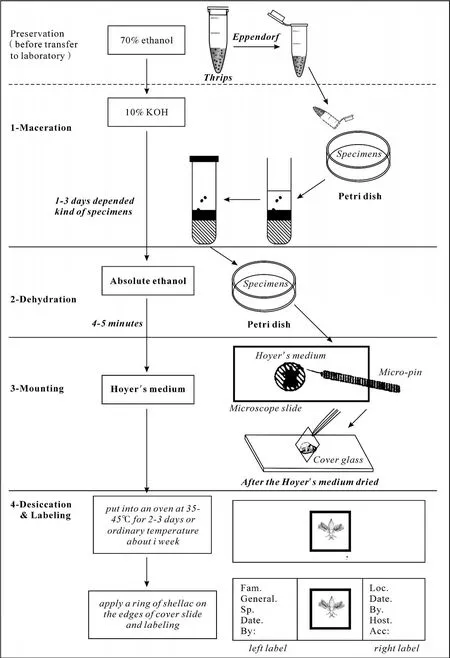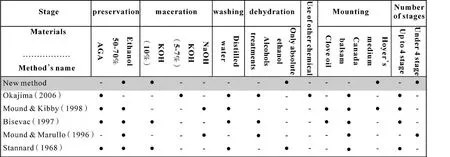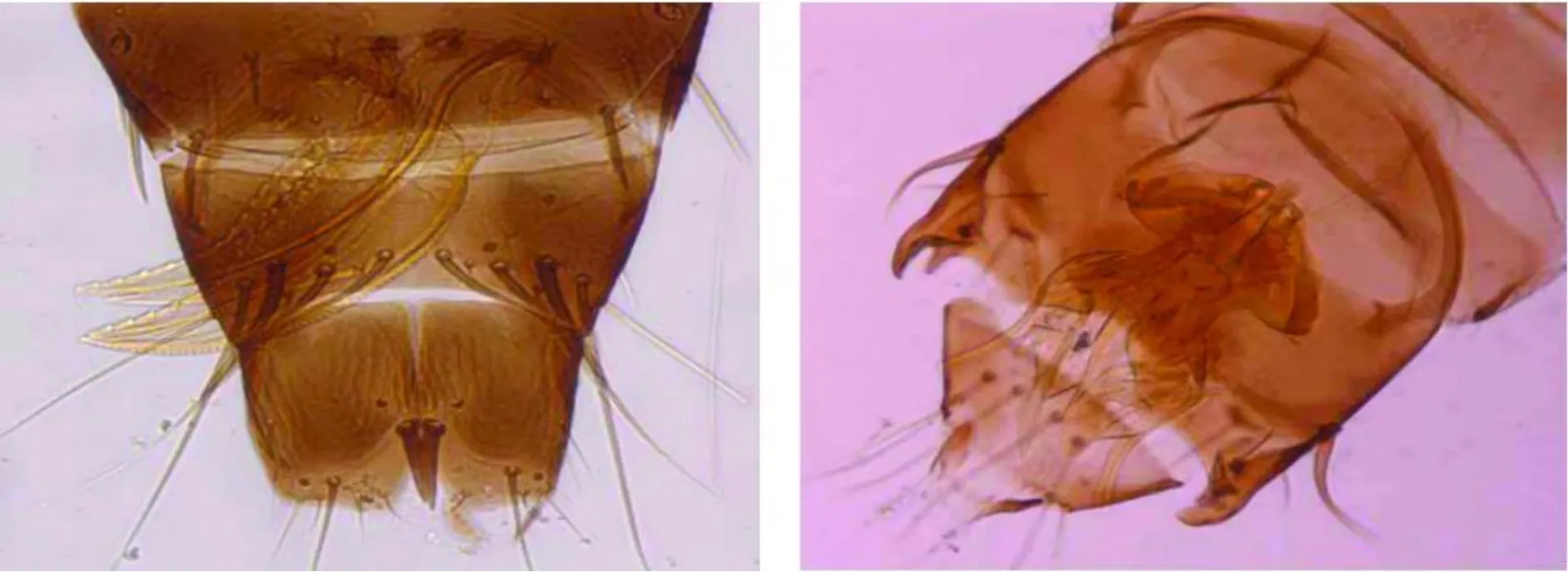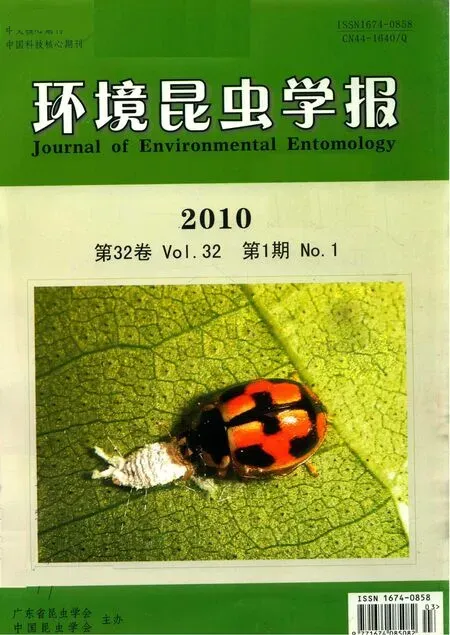一種用于顯微觀察的薊馬標(biāo)本的制片新方法
M.Mirab-Balou,陳學(xué)新
(浙江大學(xué)昆蟲科學(xué)研究所水稻國家重點(diǎn)實(shí)驗(yàn)室,杭州 310029)
The Thysanoptera areopportunistic species exploiting intermittently occurring environments.Thysanoptera constitute a well-defined order of insects of considerable economic importance,including those comparatively small-sized insects more frequently referred to as thrips(Stannard,1968;Mound&Kibby,1998).They are more abundant in the tropics,and around 7500 species have been recorded from all over the world(Mound,2009).Thrips dwell in variable habitats,and several species occur in strictly limited microhabitats.Most of them are phytophagous,inhabiting tender foliage,flowers,grass sheaths,and plant galls.Others inhabit bark of living and dead trees,drying grass clumps,and leaf litter,and are mycophagous,feeding on spores and fungal hyphae.A few are known to be predaceous,but they feed on other species of thrips,mites,whiteflies,and coccids(Stannard,1968;Lewis,1997;Mound&Kibby,1998).Their adaptive diversity has enabled successful exploitation of diverse niches,so that they have established themselves not only in a variety of plant formations,but in fungus-infested habitats such as plant litter and in bark of living and dead trees(Lewis,1997;Mound,2005).
Thrips can be collected from a plant,a growing terminal,a single flower,or a leaf by beating the vegetation over a white plastic tray.They also can be collected using a small aspirator equipped with fine thrips screen and use of Berlese funnel for collecting thrips that live in soil such as leaf-litter thrips.
The small size of thrips and many other small insects,such as aphids,parasitic wasps,scale insects,booklice,lice and mites,as well as the necessity of clearly seeing minute details of larger insects,requires examination under a compound microscope at high magnification.Such specimens and parts of specimens must thereforebespecially prepared and placed temporarily or permanently on microscope slides(Mirabbalou et al.,2008;Schauff,2009).Insect and spider body parts(e.g.mouthparts and genitalia),and larvae often have to be slide-mounted.Microscope slide mounts may be temporary or permanent,but specimens maintained in collections require permanent mounts.Each particular arthropod group requires a specialized preparation and mounting technique,so it is advisable to consult a specialist or the relevant literature before attempting to make slides(Uys&Urban,1998;Millar et al.,2000;Mirab-balou et al.,2008).Good taxonomy is an exercise in probability statistics.Morphological characters vary in their presence or absence within species as well as between species.Hence the probability of observing the full range of variability within any taxon depends on the size,number and dispersion of the available samples.This is not just a matter of the number of specimens collected,but also a function of the number of available and critically mounted specimens on which detailed comparisons can be made(Mound&Marullo,1996).Taxonomic specimens kept in good condition offer much exact information of morphological characters to taxonomists,and thus taxonomists need to endeavor to prepare specimens in good condition for serious study.Moreover,these specimens must be preserved permanently without any damage or reduction for future study(Okajima,2006).The information given in this paper will provide the readers with a good method for preparing specimens of small insects for microscopic examination.
1 Material and methods
1.1 Materials
The materials used in this method include:70%alcohol,absolute ethanol,10%KOH(made by placing 14 pellets into 50 mL of distilled water),Hoyer's medium(distilled water 50cc+gum arabic 30gr+chloral hydrate 200gr+glycerin 20cc),microscope slides,cover glass,and insect-pins.
1.2 Methods
Thrips can be counted or removed with a fine brush into collecting vials containing 70%alcohol or AGA(a mixture of 10 parts of 60%ethyl alcohol with 1 part of glycerin and 1 part of acetic acid).Although AGA helps to distend the body of most thrips and keeps the body parts supple,but 70%-90%ethanol followed by storage in a freezer can yield good microscope slides.Specimens stored in alcohol should be kept in the dark with low temperatures.The best tubes for field useare plastic Eppendorf tubes,as used in laboratories for centrifuging(Fig.1).Ensure that each tube contains a label written in pencil.Preparation of preserved material for use in optical phase contrast and interference microscopy,it needs to prepare specimens transparency and clear,which is known as maceration.
The new method for permanent mounted specimens includes 4 steps as follow(Fig.1):

Fig.1 A method for permanent mounting thrips by Hoyer's medium
1)Maceration:Specimens killed and stored in 70%ethanol should be macerated in 10%KOH with use of micro-pine.The duration of treatment must be determined by experiments.Heat KOH in water indirectly at 100°C for 1-2 h(because it is impossible to heat KOH directly)or keep it in Eppendorf tube(close door Eppendorf to prevent crystallization of KOH)in room temperature about 24-48 h.Very dark specimens should be in 10%KOH about 3-4 h in water indirectly at 100°Cor 2-3 days in room temperature;
2)Dehydration:Transfer toabsolute ethanol for 4-5 min;
3)Mounting:Put a drop of Hoyer's medium on the center of microscope slide,and then transfer the specimen from ethanol to the slide,mount the wings,legs and antennae by pressing on the basal segments with a fine needle,and put the cover glass;
4)Desiccation:Slides should be put into an oven at 35-45°C for 2-3 days or keep in room temperature about 1 week in a horizontal position.The duration for drying a slide is variable depending on the medium,size of specimen,and other factors such as humidity.After the Hoyer's medium dried,apply a ring of shellac on the edges of cover glass to seal it to prevent air influence.
An insect specimen is of limited value if it is not labeled with its original data.In this case,we recommend using of two labels,one at the left containing identification data includes sex,names of family,genus and species etc.;and the other oneat the right containing collection data includes host plant,followed by the collecting locality and date,collector's name and code number.It's necessary to say that the head of the thrips should be directed toward you when you label the slide specimen.All slides should be numbered to ensure that each slide has a unique serial number,the code number.All data should be written clearly with permanent ink.The date of collection is vital and should never be compromised.The name of the collector is important for attributing responsibility,or glory,for each specimen.
Results and disccusion
Slide mounts should fall into two categories:1)Temporary mounts,which are not intended for long term preservation,but can be used for detection of field characteristics like ecological examination,population estimation,etc.This method is recommended for all routine identification works.Temporary mounts can be prepared with several commercially available mounting media.Such slides may be kept for a year or more,but because they take up more space in a collection than permanent slides,the specimens eventually are usually placed in vials of alcohol for storage;and 2)Permanent mounts,which,is properly prepared,will be of a quality suitable for taxonomic study,and will last indefinitely.The objective is to prepare specimens onto slides with their shape and color retained in a condition as close as possible to the natural and living state but with the body cleared so that surface detail is visible.This ideal aimis difficult to achieve,and a compromise must be adopted(Uys&Urban,1998;Schauff,2009).
Since only the sclerotic or chitinized parts of the insects are ordinarily needed in a preparation,the aim of maceration is to eliminate external secretions,foreign matter,some organs,muscles,and fat bodies without damage to chitinous parts.This is accomplished by immersing the specimen in asuitableagent,such as a potassium hydroxide(KOH),sodium hydroxide(NaOH)solution,lactic acid,and lactophenol.These chemicals are strongly caustic and must be handled carefully to avoid damage to the skin and eyes(Schauff,2009).Potassium hydroxide(KOH)for maceration must be used cautiously because specimens may be easily and quickly damaged.The duration a specimen is left in the maceratingagent depends on the degree of sclerotization and the age and pigmentation of the specimen.
Hoyer's medium is a rapid permanent mounting medium which has been in general use for many years by entomologists and more especially acarologists.It has been found to be quite satisfactory for mounting small insects and mites,and specimens that have been preserved for more than twenty years without deterioration.Hoyer's medium and polyvinyl alcohol(PVA)are aqueous mounting media.The difference between PVA and Hoyer's is PVA has polyvinyl alcohol and Lactic Acid but not gum Arabic;and this point is important that some formulations of PVA will be depraving rapidly.Slides made with Hoyer's medium in the U.S.National Collection of Insects at the Smithsonian Institution,some 40-year-old slides of mites are still in good condition.Nevertheless,many other slides show significant deterioration after only a few years,even when ringed by shellac(Krantz,1978;Evans,1992;Schauff,2009);but its usual that a few slides prepared with every methods and materials,is nature that some slides will deteriorate passing time.
The techniques and materials used in preparing specimens for high-power microscopic examination are variable in different researches.There are several methods described in the literatures for mounting thrips on the slides.Mound&Pitkin(1972)interpreted in detail their excellent methods.The most detailed and precise one is described by Palmer et al.(1989),but it is a very slow process taking 2-3 days,with some dark specimens still not being thoroughly cleared(Bisevac,1997).The method described by Oetting et al.(1993),although much shorter,uses some very dangerous chemicals(such as xylol),and some specimens are still not clear enough(Oetting et al.,1993).Bisevac(1997)published a paper about a new method for mounting thrips on slides,but his method used some chemical such as clove oil and Canada balsam that are not available everywhere and relatively expensive.The method described here is the shortest one,needs fewer chemical materials(Table 1)and especially it is suitable for dark specimens(such as thrips of the family Phlaeothripidae).It also allows us to identify thrips specimens rapidly and accurately because the mounted specimens areclear and retain their original colors,which is often necessary for identification.It is necessary to point out that there is no need of piercing abdomen of thrips to evacuate its contents in this method.Some specimens that have been prepared with this method are shown in Figures 2 to 4.

Table 1 Comparison of our new method with others
Because most of amateurs use lactophenol or nesbit to clear body of mites,they think these materials are usable for thrips too.However,when we used these materials for clearing body of thrips,we found that the thrips specimens had not been cleared and furthermore lactophenol or nesbit were crystallized around body of thrips after several days.So we strongly recommend that lactophenol or nesbit should not be used for clearing body of thrips.
Acknowledgements We wish to thank Prof.Tong Xiaoli and Prof.Zhang Weiqu(South China Agricultural University,Guangzhou,China)for their supplying some references and providing helpful comments.

Fig.2 Frankliniella sp.,head and pronotum(200x)(left)and ctenidia on tergite VIII(400x)(right)

Fig.3 Limothrips sp.,abdominal segmented IX-X(left)and Aeolothrips sp.(right)(200X)

Fig.4 Aeolothrips sp.,sensorial on antennae segmented III-IV(400X)(left)and Aptinothrips rufus,head and antennae(200x)
References)
Bisevac L,1997.A new method for mounting thrips(Thysanoptera)on slides.Australian Journal of Entomology,36:220.
Evans GO,1992.Principles of Acarology.C.A.B.International,Wallingford,563.
Krantz GW,1978.Mannual of Acarology.(Second Edition).Oregon State University,Book Stores,Inc.,Corvallis,507.
Lewis T,1997.Thrips as Crop Pests.CAB International,Wallingford,U.K.349.
Millar IM,VM Uys,RP Urban,2000.Collecting and Preserving Insects and Arachnids.A Manual for Entomology and Arachnology.Ultra Litho(Pty)Ltd,Heriotdale,Johannesburg,112.
Mirab-balou M,HR Pourian,Sh.Pishevar,2008.Entomology and Pest Managements.Marze danesh Publication,206(In Persian).
Mound LA,2009.Thysanoptera(thrips)of the world-a checklist.A-vailable online at: http://www.ento.csiro.au/thysanoptera/worldthrips.html.
Mound LA,G Kibby,1998.Thysanoptera:An Introduction Guide,2nd Edition,CAB International,UK.,70.
Mound LA,2005.Thysanoptera:diversity and interactions.Annu.Rev.Entomol.,50:247-69.
Mound LA,Pitkin BR,1972.Microscopic whole mounts of thrips(Thysanoptera).Entomologist's Gazette,23:121-125.
Mound LA,Marullo R,1996.The thrips of central and South America:An introduction.Memoirs on Entomology,International,6:1-448.
Oetting RD,Beshearr J,Liu TX,Bramans K,Baker JR,1993.Biology and identification of thripson greenhouse ornamentals.Georgia Agricultural Experiment Stations,Research Bulletin,414:1-20.
Okajima S,2006.The Suborder Tubulifera(Thysanoptera).The Insects of Japan.The Entomological Society of Japan,Touka Shobo Co.Ltd.,Fukuoka,2:1-720.
Palmer JM,Mound LA,Du Heaumge J,1989.CIE Guides to Insects of Importance to Man.2.Thysanoptera.CAB International Institute of Entomology and British Museum(Natural History),London,73.
Schauff ME,2009.Collecting and preserving insects and mites:techniques and tools.U.S.Department of Agriculture,Systematic Entomology Laboratory.69.In:http://www.ars.usda.gov/Main/site_main.htm?docid=10141&page=1
Stannard LJ,1968.The Thrips,or Thysanoptera,of Illinois.Bulletin of the Illinois Natural History Survey,29:213-552.
Uys VM,Urban RP,1998.How to collect and preserve insects and arachnids.The Plant Protection Research Institute,Agricultural Research Council of South Africa,73.

